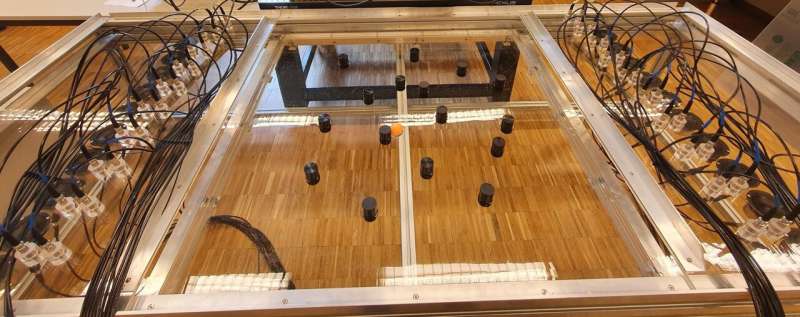This article has been reviewed according to Science X's editorial process and policies. Editors have highlighted the following attributes while ensuring the content's credibility:
fact-checked
peer-reviewed publication
trusted source
proofread
Researchers move floating objects with soundwaves

EPFL researchers have succeeded in directing floating objects around an aquatic obstacle course using only soundwaves. Their novel, optics-inspired method holds great promise for biomedical applications such as noninvasive targeted drug delivery.
In 2018, Arthur Ashkin won the Nobel Prize in Physics for inventing optical tweezers: laser beams that can be used to manipulate microscopic particles. While useful for many biological applications, optical tweezers require extremely controlled, static conditions to work properly.
"Optical tweezers work by creating a light 'hotspot' to trap particles, like a ball falling into a hole. But if there are other objects in the vicinity, this hole is difficult to create and move around," says Romain Fleury, head of the Laboratory of Wave Engineering in EPFL's School of Engineering.
Fleury and postdoctoral researchers Bakhtiyar Orazbayev and Matthieu Malléjac have spent the last four years trying to move objects in uncontrolled, dynamic environments using soundwaves. In fact, the team's method—wave momentum shaping—is entirely indifferent to an object's environment or even its physical properties. All the information that's required is the object's position, and the soundwaves do the rest.
"In our experiments, instead of trapping objects, we gently pushed them around, as you might guide a puck with a hockey stick," Fleury explains.
The unconventional method has been published in Nature Physics in collaboration with researchers from the University of Bordeaux in France, Nazarbayev University in Kazakhstan, and the Vienna University of Technology in Austria.
If soundwaves are the hockey stick in Fleury's analogy, then a floating object like a ping-pong ball is the puck. In the lab's experiments, the ball was floating on the surface of a large tank of water, and its position was captured by an overhead camera. Audible soundwaves emitted from a speaker array at either end of the tank directed the ball along a pre-determined path, while a second array of microphones 'listened' to the feedback, called a scattering matrix, as it bounced off of the moving ball.
This scattering matrix, combined with the camera's positional data, allowed the researchers to calculate in real time the optimal momentum of the soundwaves as they nudged the ball along its path.
"The method is rooted in momentum conservation, which makes it extremely simple and general, and that's why it's so promising," Fleury says.
He adds that wave momentum shaping is inspired by the optical technique of wavefront shaping, which is used to focus scattered light, but this is the first application of the concept to moving an object. What's more, the team's method is not limited to moving spherical objects along a path: they also used it to control rotations, and to move more complex floaters like an origami lotus.
Mimicking conditions inside the body
Once the scientists succeeded in guiding a ping-pong ball, they performed additional experiments with both stationary and moving obstacles designed to add inhomogeneity to the system. Successfully navigating the ball around these scattering objects demonstrated that wave momentum shaping could perform well even in dynamic, uncontrolled environments like a human body. Fleury adds that sound is a particularly promising tool for biomedical applications, as it is harmless and noninvasive.
"Some drug delivery methods already use soundwaves to release encapsulated drugs, so this technique is especially attractive for pushing a drug directly toward tumor cells, for example."
The method could also be a game-changer for biological analysis or tissue engineering applications where manipulating cells by touching them would cause damage or contamination. Fleury also sees 3D printing applications for wave momentum shaping, for example to arrange microscopic particles before solidifying them into an object.
Ultimately, the researchers believe their method could also work using light, but their next goal is to take their sound-based experiments from the macro- to micro-scale. They plan to do experiments under a microscope, using ultrasonic waves to move cells around.
More information: Bakhtiyar Orazbayev et al, Wave-momentum shaping for moving objects in heterogeneous and dynamic media, Nature Physics (2024). DOI: 10.1038/s41567-024-02538-5
Journal information: Nature Physics
Provided by Ecole Polytechnique Federale de Lausanne

















